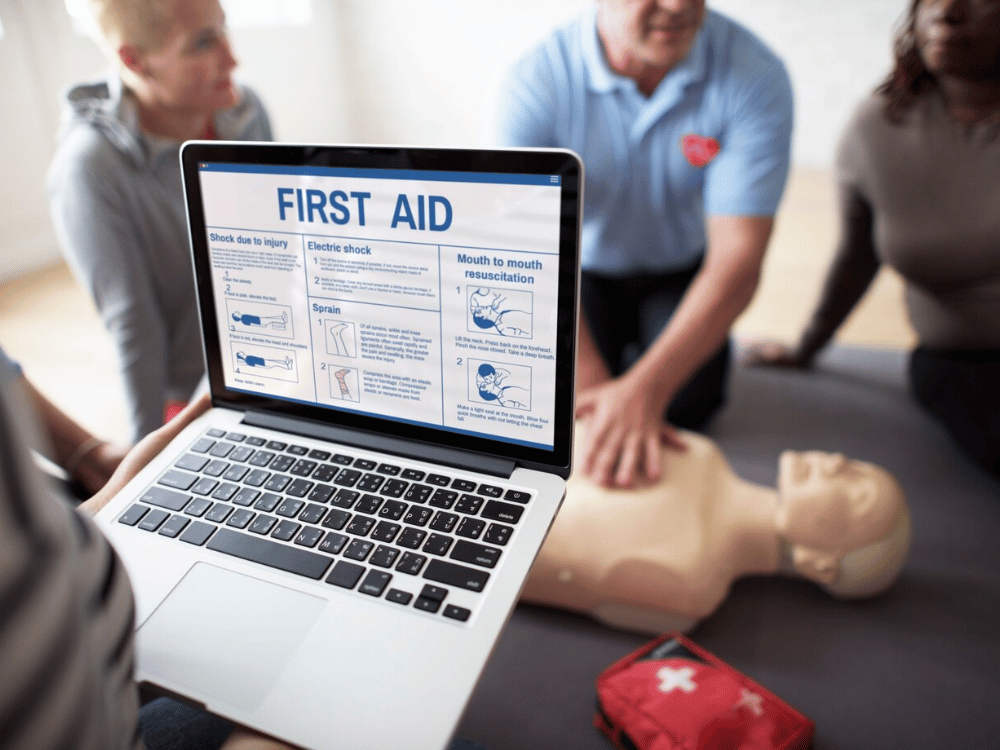Over 560,000 UK workers sustained a self-reported non-fatal injury in 2022/23.
Following the nine principles of prevention can create a robust workplace safety strategy. But when accidents do occur, your business’s processes should be equally durable.
One key component to assuring that reliable approach is having an accident book in your workplace.
In this article, we’ll unpack what makes accident book reporting crucial.
We’ll detail who should manage them and why they need appropriate training. We’ll also cover how completing the IOSH Managing Safely course with TSW Training can help you meet that requirement.
What is an Accident Book?
According to the Health and Safety Executive (HSE), the Accident Book is: “An essential document for employers and employees, who are required by law to record and report details of specified work-related injuries and incidents.”
Both The Social Security (Claims and Payments) Regulations 1979 (SSCPR) and the Reporting of Injuries, Diseases and Dangerous Occurrences Regulations 2013 (RIDDOR) outline that employers and employees must report any accidents.
What Information Should the Accident Book Include?
Details of what information should be recorded in your business’s accident book are:
- Full name, address, and role of the person(s) affected
- Date and time of the incident
- Location of accident
- Cause of accident
- Full name, address, and role of reporting party (if different from the injured person)
- Details of first aid administered
Wherever possible, it’s best to ensure that details around when, where, and how the incident occurred are filled out by the affected person.
When the injured party provides this information, it allows for a more balanced investigation.
You may also like to include details of any additional safety measures implemented as a result of the incident.
When is an Organisation Legally Required to Have an Accident Book?
The guidance from HSE outlines that employers are legally obliged to keep an accident book on-site. However, this isn’t completely true.
If your business employs less than 10 people, under RIDDOR rules, you can download accident reporting forms rather than keeping a record on-site.
Having said that, reporting all workplace accidents in a central record is a much more streamlined approach.
Additionally, when not keeping a record on the premises, there is a temptation for workers or managers to not report minor incidents.
All workplace accidents need to be recorded to comply with legal guidance and as a reference point (should they develop into bigger issues).
For example, small head injuries at work may not seem reportable at the time. However, symptoms of concussion can take up to three weeks to show.
Importance of Accident Book In the Workplace
As mentioned, an accident reporting book is a legal requirement for business owners with more than 10 staff members.
But it’s also an essential document for many other reasons. Let’s unpack those now.
Track and Record Accidents and Incidents
Reporting incidents not only allows compliance with RIDDOR and SSCPR laws, but it can also help improve the safety culture in your workplace.
Links between a positive safety culture and productivity have been proven. For example, American aerospace firm Lockheed Martin saw a 24% increase in productivity when it improved the safety culture at their Paducah Plant.
Workers who feel looked after are more engaged with their work and the business.
Employers demonstrate that staff safety is paramount by providing a robust reporting process for all incidents (no matter how minor).
Identify Patterns or Trends in Accidents
Reporting all incidents in the accident book can also help highlight any worrying incident trends.
According to HSE statistics, around 32% of the injuries reported under RIDDOR in 2022/23 were slips, trips, or falls.
Considering those stats, it’s fair to assume that this number could be reduced through accident book reporting. By starting the incident feedback loop early, owners and managers can quickly mitigate the risk to workers.
To put those injury statistics into perspective, the number of working days lost to sickness or injury in 2022 was 185.6 million, representing a nearly 24% increase from the previous year.
Imagine what those absences could be doing to your business’s productivity.
Comply with Health and Safety Regulations
As mentioned, accident book reporting is necessary for your business to comply with current safety laws.
Businesses with under 10 employees may be exempt from certain legalities. However, every effort must be made to report incidents via the RIDDOR downloadable forms.
Support Insurance Claims
Your business’s accident book is seen as vital evidence when compiling insurance claims. Failure to report accidents at work can have several implications.
When personal injury or insurance claims are made, solicitors and insurance firms will request records of the accident book to verify details of the incident.
Not only will a complete record afford them these details, but it will also allow them to corroborate information, including injuries or damage sustained.
Legislation and Legal Requirements Related to Accident Books
Now we know your accident book is a legal requirement rather than just a register of incidents. So, let’s look at the legislation propping it up.
Health and Safety at Work Act 1974 (UK)
Section 2 of the Health and Safety at Work Act 1974 (HASWA) outlines that employers must provide a safe working environment.
One way to develop a safe workplace is by ensuring that incident reporting lines are as open as possible.
To further define this reporting process, you can ensure that the accident report book plays a formal role in your business’s health and safety policy.
Additionally, staff training is incredibly important in creating this super safe space. Section 2 of HASWA also calls for role-appropriate training. Developing your management team by enrolling them in the IOSH Managing Safely course can help emphasise the importance of incident reporting.
Reporting of Injuries, Diseases, and Dangerous Occurrences Regulations (RIDDOR)
The RIDDOR guidance mandates employers keep records of incidents such as:
- Work-related deaths
- Work-related injuries that cause specified injuries
- Injuries which cause workers to be incapacitated for over seven days
- Cases of industrial disease
- Any dangerous occurrences happening at general workplaces, offshore locations, or specific workplaces such as quarries, mines, and transport systems
However, it’s worth mentioning that only ‘responsible people’ such as the employer or a Line Manager who is up to date with their NEBOSH or IOSH qualifications can report incidents under RIDDOR.
GDPR Compliance Regarding Data Protection in Accident Books
Earlier, we mentioned the necessity for sensitive employee information to be recorded in the accident report book. But this raises potentially awkward issues from a GDPR perspective.
The documentation should be stored securely to ensure that you have a GDPR-compliant accident book process. Details outlined in the report should only be shared with:
- Other safety representatives
- Governmental departments
- Insurance companies – as part of an ongoing claim
- Agents from the HSE
Section 25 of the SSCPR also dictates that employers should keep incidents in the accident book for three years.
Best Practices for Managing Accident Books
A robust reporting process is about more than simply making the accident book available to injured employees. The implementation of reporting best practices is also essential.
Regularly Review and Analyse Recorded Accidents
As with many health and safety policies, such as running risk assessments, you should aim to review your policies and procedures at least once a year.
The same can be said for reviews of your accident reporting processes. An alternative and valid approach is conducting reviews after every incident – this could help reduce repeat incidents.
Communicate and Train on Accident Book Procedures
Communication of procedural changes, especially to health and safety practices, is pivotal for ensuring buy-in from staff and management.
Effective communication can ensure employees know what to do in order to stay safe at work. But it can also mean they’re aware of the first steps to reporting an incident.
Leveraging training courses such as IOSH Managing Safely can also help drive that understanding of accident books and safety management in your leadership team.
Maintain Confidentiality and Data Protection
Once the reporting process is in place, those details must stay on record for up to three years.
However, as we mentioned earlier, this requirement means confidentiality is imperative. Accident books should be stored securely, and digital versions should be password-protected on secure servers.
Perform Periodic Audits and Checks for Compliance
Performing regular audits of the accident book can help you stay across any emerging incident patterns.
When patterns occur, work swiftly to communicate findings and gather feedback from staff to ascertain why accident repetition is happening.
Moreover, you should also think about including general observations as part of your safety reviews.
Implementing a Plan, Do, Check, Act Model can be extremely effective for driving continuous improvement in your business’s safe working procedures.
Different Types of Accident Books
You may think an accident book is exactly what it says on the proverbial tin. But these reporting vessels can come in a few different forms.
A4 Accident Books for Larger Organizations
The bigger the business, the more employees, and the more employees, the more potential incidents.
With this in mind, larger businesses might need a greater ledger to include all incident details.
Alternatively, if your site is a quarry, construction site, mine, manufacturing plant, or other premises where risks and hazards are common, then A4 ledgers would be more suitable.
A5 Accident Books for Small Businesses and Schools
Although smaller businesses with less than 10 employees don’t need to keep an accident book, you should consider using an A5 document.
The smaller records will be easier to store securely, offering sufficient space for compliant data entry.
Electronic Accident Reporting Systems
You can also opt for a digital solution. Accident and incident management software helps you stay compliant while streamlining the reporting of incidents under RIDDOR.
However, as we mentioned earlier, for full coverage, many businesses also choose to have a hard copy of the accident book on-premise to improve reporting speed and accuracy.
Frequently Asked Questions (FAQs)
Here are some frequently asked accident book questions:
Can an Accident Book be Used as Evidence in Legal Proceedings?
Incident data added to accident books can support an argument in legal hearings. However, you should ensure that your ledger allows users to enter all the necessary incident details. These are:
- Full name, address, and role of the person(s) affected
- Date and time of the incident
- Location of accident
- Cause of accident
- Full name, address, and role of reporting party (if different from the injured person)
- Details of first aid administered
Why is it Important to Review the Accident Book?
Reviewing the entries in your workplace’s accident book can help managers identify patterns in incident reporting. It can also provide a measure of how many accidents are occurring on your premises each year.
Who is Responsible for Filling in the Accident Book?
Although the injured party should enter details about how and when incidents occurred, anyone can add entries to the accident book. However, these entries should be overseen by HR personnel or a first aider.
Additionally, only a responsible person can report incidents under RIDDOR rules.
When Must An Entry Be Made In The Accident Book?
Any injury at work, no matter how minor, should be entered into the accident book. Reporting should take place as soon as possible to ensure clarity.
If reporting under RIDDOR is necessary, this should be completed no later than 10 days after the incident.
How Long Do You Have to Put an Accident in the Accident Book?
Details of accidents should remain in the incident book for up to three years after the occurrence.
Can An Accident Book Be Electronic?
Yes. Your accident book can be digital, in fact, this can help with the speed of reporting under RIDDOR.
However, many businesses prefer an on-site record for ease of auditing and to ensure details are entered as quickly after the incident as possible.
Conclusion
Your business’s accident book is more than just a record of all the safety issues on your premises. It can help drive improvements in incident reporting processes and overall safety culture.
To help cement these improvements, you can enhance your team’s procedural safety understanding by enrolling them in the IOSH Managing Safely course.
At TSW Training, our +99% pass rate on this assessment ensures your team gets the best guidance.













